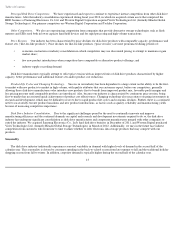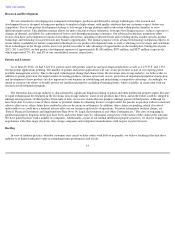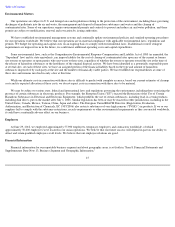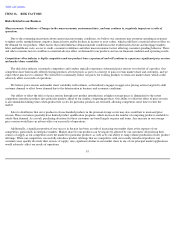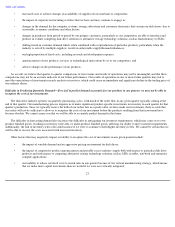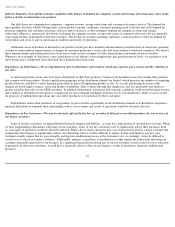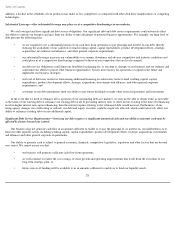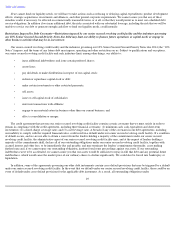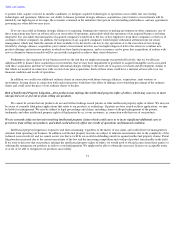Seagate 2011 Annual Report Download - page 25
Download and view the complete annual report
Please find page 25 of the 2011 Seagate annual report below. You can navigate through the pages in the report by either clicking on the pages listed below, or by using the keyword search tool below to find specific information within the annual report.
Table of Contents
• dependence on our ability to successfully qualify, manufacture and sell in increasing volumes on a cost-effective basis and with
acceptable quality our disk drive products, particularly the new disk drive products with lower cost structures;
• variations in the cost of components for our products, especially during periods when the U.S. dollar is relatively volatile as
compared to other currencies;
•
uncertainty in the amount of purchases from our distributor customers who from time to time constitute a large portion of our total
sales;
• our product mix and the related margins of the various products;
•
accelerated reduction in the price of our disk drives due to technological advances and/or an oversupply of disk drives in the
market and shifting trends in demand which can create supply and demand imbalances;
• manufacturing delays or interruptions, particularly at our manufacturing facilities in China, Malaysia, Northern Ireland,
Singapore, Thailand or the United States;
•
limited access to components that we obtain from a single or a limited number of suppliers;
• the impact of changes in foreign currency exchange rates on the cost of producing our products and the effective price of our
products to foreign consumers; and
•
operational issues arising out of the increasingly automated nature of our manufacturing processes.
New Product Offerings
—Market acceptance of new product introductions cannot be accurately predicted, and our results of operations will
suffer if there is less demand for our new products than is anticipated.
We are continually developing new products with the goal that we will be able to introduce technologically advanced and lower cost disk
drives into the marketplace ahead of our competitors.
The success of our new product introductions is dependent on a number of factors, including market acceptance, our ability to manage the
risks associated with product transitions, the effective management of inventory levels in line with anticipated product demand and the risk that
our new products will have quality problems or other defects in the early stages of introduction that were not anticipated in the design of those
products. Accordingly, we cannot accurately determine the ultimate effect that our new products will have on our results of operations.
In addition, the success of our new product introductions is dependent upon our ability to qualify as a primary source of supply with our
OEM customers. In order for our products to be considered by our customers for qualification, we must be among the leaders in time-to-market
with those new products. Once a product is accepted for qualification testing, any failure or delay in the qualification process or a requirement
that we requalify can result in our losing sales to that customer until new products are introduced. The limited number of high-volume
OEMs magnifies the effect of missing a product qualification opportunity. These risks are further magnified because we expect competitive
pressures to result in declining sales, eroding prices, and declining gross margins on our current generation products. We cannot assure that we
will be among the leaders in time-to-
market with new products or that we will be able to successfully qualify new products with our customers in
the future.
If we cannot successfully deliver competitive products, our future results of operations may be adversely affected.
22



